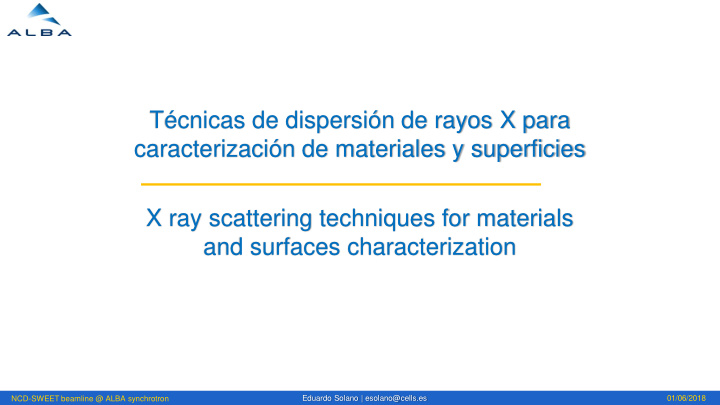



Técnicas de dispersión de rayos X para caracterización de materiales y superficies X ray scattering techniques for materials and surfaces characterization Eduardo Solano | esolano@cells.es 01/06/2018 NCD-SWEET beamline @ ALBA synchrotron
NCD-SWEET beamline 2 Beamline dedicated to Small Angle X-ray Scattering (SAXS) technique, which provides information about differences on electronic density in the material. It can be combined with Wide Angle X-ray Scattering (WAXS). SAXS proves structure information between 1 - 300 nm WAXS provides crystalline structure recording Bragg peaks Small Angle X-ray Scattering Wide Angle X-ray Scattering sample Scattered radiation X-ray beam Eduardo Solano | esolano@cells.es 01/06/2018 NCD-SWEET beamline @ ALBA synchrotron
NCD-SWEET beamline 3 SAXS WAXS DECTRIS webinar 15/05/2018 SAXS detector WAXS detector NCD-SWEET beamline Eduardo Solano | esolano@cells.es 01/06/2018 NCD-SWEET beamline @ ALBA synchrotron
SAXS requires electronic contrast 4 SAXS is caused by differences on the electron density between a material and its surrounding matrix. The contrast in SAXS is the difference of electron densities (shown When the monster came, Lola, like the peppered moth as pink color) between particle and environment. A pink panther in remained motionless and undetected. Harold, of course, a pink room is invisible with the exception of the nose which was immediately devoured. remains visible due to its non-zero contrast. 1 1 The SAXS Guide , 3 rd edition. Anton Paar GmbH 2013 Eduardo Solano | esolano@cells.es 01/06/2018 NCD-SWEET beamline @ ALBA synchrotron
Why do we need SAXS? 5 Transmission Electron Microscopy Small Angle X-ray Scattering - Real Space image - Reciprocal Space image - High resolution for small details - Low resolution - Small analyzed area - Large analyzed area - Pictures are unique but not - Average data are obtained always representative - Small details are visible - Small details are not visible - Sample preparation required - Minimum sample preparation - In situ conditions limited - Wide range of in situ conditions Eduardo Solano | esolano@cells.es 01/06/2018 NCD-SWEET beamline @ ALBA synchrotron
SAXS applications 6 Acta Materialia 54 (2006) 4793 – 4801 Eduardo Solano | esolano@cells.es 01/06/2018 NCD-SWEET beamline @ ALBA synchrotron
SAXS applications 7 • Particle radius • Volume fraction Acta Materialia 54 (2006) 4793 – 4801 Eduardo Solano | esolano@cells.es 01/06/2018 NCD-SWEET beamline @ ALBA synchrotron
SAXS applications 8 … (ii) The response of the base material to friction stir welding includes all the stages of precipitate evolution: dissolution, growth, coarsening and even nucleation of new phases. Coarsening is the most detrimental effect as it prevents the material from recovering its mechanical properties, either by natural ageing or by post-weld heat treatments . … (iii) The welding speed (which determines the heat generation per unit time and welded length) is a key factor in controlling the extent of the precipitate evolution irrespective of the initial state (T3 or T79). …it affects the peak temperature but also the temperature gradient. In this respect a lower welding speed will favour coarsening and a broader microstructurally affected zone. … Acta Materialia 54 (2006) 4793 – 4801 Eduardo Solano | esolano@cells.es 01/06/2018 NCD-SWEET beamline @ ALBA synchrotron
Surface investigations 9 Grazing Incidence SAXS (GISAXS) fulfill the necessity to investigate nanoscale objects at surfaces, buried interfaces or in thin films. GISAXS disadvantages: GISAXS advantages: Electron density contrast Non-destructive: hard x-ray beam Low surface roughness Surface sensitive: grazing incidence Multiple scattering contributions Large sample area: large beam footprint Difficulties on data analysis Versatile: Wide range of conditions Eduardo Solano | esolano@cells.es 01/06/2018 NCD-SWEET beamline @ ALBA synchrotron
Surface investigations 10 Experimental GISAXS patterns obtained from films prepared from P-123. (a) As-cast film with alumina only, (b) the same film after calcination to 400 o C, leading to a collapsed and essentially isotropic structure. Journal of Material Chemistry A ,2014, 2, 9727 – 9735 Journal of Colloid and Interface Science 345 (2010) 120 – 124 Eduardo Solano | esolano@cells.es 01/06/2018 NCD-SWEET beamline @ ALBA synchrotron
Surface investigations 11 … The porosity of the mesoporous alumina films could be controlled between 5% and 37% by varying the surfactant concentration. The pore structure of the ordered mesoporous alumina films was confirmed as a body-centered cubic structure from GISAXS patterns. However, excessively high surfactant concentrations led to a collapse of the ordered pore structure, which causes a reduction in porosity, and a disordered pore structure. As porosity of mesoporous alumina increases, thermal conductivity decreases but mechanical properties are degraded. Ordering in the pore structure improves mechanical properties as the structure allows a better distribution of stress. Specially, the relations between pore structure and mechanical property/thermal conductivity, which were not merely noted in previous literatures, were analyzed in this work, and the fact that a pore distribution as well as porosity is important in mechanical and thermal properties of mesoporous materials was deduced from these relations. Eduardo Solano | esolano@cells.es 01/06/2018 NCD-SWEET beamline @ ALBA synchrotron
In situ data acquisition 12 “ In situ 2D Grazing Incident Small-angle X-ray Scattering (GISAXS) is a powerful tool to investigate the structure of self- assembled nanostructure coatings .” “The in situ grazing incident small angle X -ray scattering (GISAXS) was used to investigated the structure evolution of the ordered mesoporous silica coating during the calcination process .” C: mesoporous silica coating CN: After Ammonia exposure (30 min) and thermal treatment (350 o C, 3h) CNH: After exposure to HMDS (hexamethyldisilazane) CNHH: After a second exposure to HMDS (hexamethyldisilazane) RSC Advances 4 (2014) 50873-50881 Eduardo Solano | esolano@cells.es 01/06/2018 NCD-SWEET beamline @ ALBA synchrotron
Summary 13 NCD-SWEET beamline provides a set of tools for ex situ and in situ investigations using (Grazing Incidence) Small Angle X-ray Scattering ((GI)SAXS) in combination with (Grazing Incidence) Wide Angle X-ray Scattering ((GI)WAXS). • (GI)SAXS provides information about scatters between 1 to 300 nm: nanoparticle size and shape distributions, pore sizes, characteristic distances of partially ordered materials, etc. • (GI)WAXS provides structural information below 1 nm: crystalline structure Eduardo Solano | esolano@cells.es 01/06/2018 NCD-SWEET beamline @ ALBA synchrotron
Recommend
More recommend